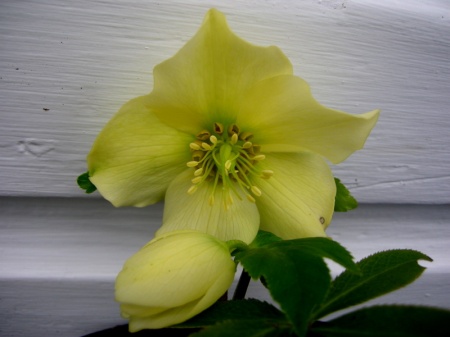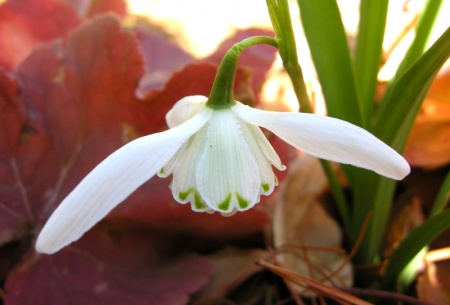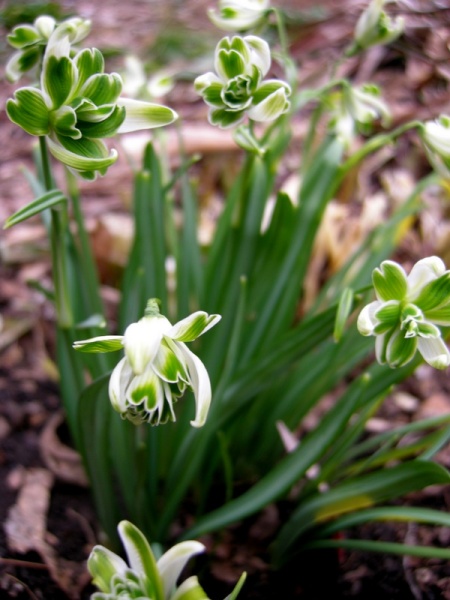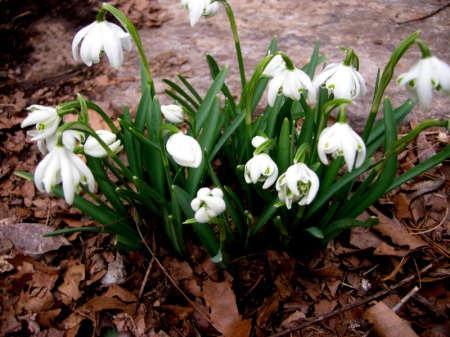 A drift of snowdrops covers the hill above the extraordinarily colored lake at Colesbourne Park. The amazing blue is caused by light reflecting off naturally deposited clay in the water. It is worth visiting just to see it.
A drift of snowdrops covers the hill above the extraordinarily colored lake at Colesbourne Park. The amazing blue is caused by light reflecting off naturally deposited clay in the water. It is worth visiting just to see it.
Our current snowdrop catalogue is on line here.
Michael and I just returned from a two week snowdrop trip to England. For six days we were the guests of Sir Henry and Lady Carolyn Elwes at Colesbourne Park in the Cotswolds. Colesbourne has been called England’s greatest snowdrop garden, and wandering through the grounds for six days I can see why. First, the 2,500 acre setting is absolutely magnificent, including the lake pictured above, a church dating back to 1067, and a charming village with a delightful pub, the Colesbourne Inn, serving delicious food.
Nursery News: Carolyn’s Shade Gardens is a retail nursery located in Bryn Mawr, PA, specializing in showy, colorful, and unusual plants for shade. The only plants that we ship are snowdrops and miniature hostas. For catalogues and announcements of events, please send your full name, location, and cell number (for back up use only) to carolyn@carolynsshadegardens.com. Click here to get to the home page of our website for catalogues and information about our nursery and to subscribe to our blog.
.
 This lovely, very large snowdrop ‘Margaret Owen’ is a fitting tribute to its namesake, a renowned galanthophile.
This lovely, very large snowdrop ‘Margaret Owen’ is a fitting tribute to its namesake, a renowned galanthophile.
.
 The double snowdrop ‘Rodmarton’ originated at the nearby Rodmarton Manor, an arts and crafts house featuring its own wonderful snowdrop collection.
The double snowdrop ‘Rodmarton’ originated at the nearby Rodmarton Manor, an arts and crafts house featuring its own wonderful snowdrop collection.
Second, you can see many rare and unusual snowdrops, like ‘Margaret Owen’ and ‘Rodmarton’ above, in large clumps instead of singly or in small groups. Colesbourne Park has over 250 varieties in its collection, and they work hard to develop each into a large stand.
.
 Sir Henry Elwes stands in a field of ‘S. Arnott’ as he entertains a guided tour with tales of Colesbourne and its snowdrops.
Sir Henry Elwes stands in a field of ‘S. Arnott’ as he entertains a guided tour with tales of Colesbourne and its snowdrops.
Third, if you are lucky enough to go on a tour, you will be taken around by Sir Henry Elwes who grew up at Colesbourne and knows all 2,500 acres intimately. His great-grandfather was Henry John Elwes, the famous Victorian plant explorer who discovered his namesake snowdrop, Galanthus elwesii, in Turkey in 1874. During the tour, Sir Henry will tell you about snowdrops, but he will also regale you with fascinating stories about Colesbourne itself.
.
 A close up of ‘S. Arnott’, called the desert island snowdrop because if galanthophiles could have just one, this would be it!
A close up of ‘S. Arnott’, called the desert island snowdrop because if galanthophiles could have just one, this would be it!
But for me, the most amazing thing about Colesbourne is the huge drifts of some of the more well known cultivars of snowdrops. As I have said before, I am not interested in having a collection of hundreds of little groups of rare snowdrops. I want plants with interesting leaves and habits as well as flowers, that are vigorous and will multiply into large clumps fairly quickly.
.
 ‘Titania’, a Greatorex double snowdrop, which has been intentionally divided and spread out at Colesbourne.
‘Titania’, a Greatorex double snowdrop, which has been intentionally divided and spread out at Colesbourne.
When Sir Henry and Lady Carolyn Elwes took over Colesbourne Park, intervening generations had not tended John Henry Elwes’s collections and many had been sold. However, some snowdrops remained, and Sir Henry and Lady Carolyn developed the current Colesbourne snowdrop display in the last 25 years. Colesbourne showed me what you could do with a snowdrop collection and why snowdrops like ‘S. Arnott’ and the others pictured below are so widely grown. It was a revelation.
.
Here are some more snowdrops that have been systematically divided to form huge stands at Colesbourne:
.
 ‘Galatea’, a large and vigorous single snowdrop, called “one of the foundation stones of many collections” by Matt Bishop’s snowdrop book.
‘Galatea’, a large and vigorous single snowdrop, called “one of the foundation stones of many collections” by Matt Bishop’s snowdrop book.
.
 ‘Galatea’ quickly turns into a good sized patch.
‘Galatea’ quickly turns into a good sized patch.
.
.
 ‘Ophelia’ is my favorite of the many Greatorex doubles and also the most widely grown.
‘Ophelia’ is my favorite of the many Greatorex doubles and also the most widely grown.
.
 ‘Ophelia’ as far as the eye can see.
‘Ophelia’ as far as the eye can see.
.
 Early-blooming ‘Mrs. Macnamara’, another much admired classic called a “plant of great quality” by the Bishop book.
Early-blooming ‘Mrs. Macnamara’, another much admired classic called a “plant of great quality” by the Bishop book.
 ‘Hippolyta’ spread far and wide.
‘Hippolyta’ spread far and wide.
.
 Galanthus plicatus ‘Colossus’, an early vigorous snowdrop with a beautiful habit and elegant leaves.
Galanthus plicatus ‘Colossus’, an early vigorous snowdrop with a beautiful habit and elegant leaves.
.
I visited some other snowdrop venues that had sweeping drifts but none with the variety found at Colesbourne. Painswick Rococo Garden is the place where the famous snowdrop ‘Atkinsii’ was first selected in the 1860s. There are amazing drifts of ‘Atkinsii’, Galanthus nivalis, and ‘Flore Pleno’ there:
.
 The very tall and stately ‘Atkinsii’ in the back with ‘Flore Pleno’ in the front at Painswick.
The very tall and stately ‘Atkinsii’ in the back with ‘Flore Pleno’ in the front at Painswick.
.
Thank you so much to Sir Henry and Lady Carolyn Elwes for opening their world, both snowdrop and otherwise, to two very grateful visitors from across the pond.
Carolyn
.
Note: Every word that appears in orange on my blog is a link that you can click for more information. If you want to return to my blog’s homepage to access the sidebar information (catalogues, previous articles, etc.) or to subscribe to my blog, just click here.























































































